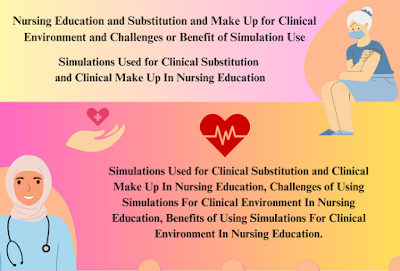The Substitution and Make Up for Clinical Environment and Challenges or Benefit of Simulation Use In Nursing Education. The role of simulation-based learning in nursing education is to bridge the gap between theory and practice and allow students to develop critical thinking, clinical skills, and confidence without putting real patients at risk.
The Substitution and Make Up for Clinical Environment and Challenges or Benefit of Simulation Use In Nursing Education
Simulations can replace or complement clinical experiences in nursing education and offer advantages such as cost-effectiveness, controlled environments, and opportunities for repeated practice. However, they are not a perfect substitute for real-life clinical practice, which offers valuable experiences such as social interactions and the unpredictability of patient care that are difficult to replicate through simulations.
The biggest challenges were the lack of a contextualized curriculum, content-intensive curricula, a lack of simulation-trained staff, and the cost of simulators. Both educators and learners cited performance anxiety as a significant challenge.
Facts and Figures Simulation USe
Simulations provide students with a safe environment to practice their skills as many times as necessary without endangering patients. However, they can be expensive, do not replicate the clinical situation, and, if poorly designed, can lead to students learning incorrect information.
1. Simulations as Clinical Substitution
Simulations are increasingly used to substitute for real clinical hours due to several challenges:
- Limited Clinical Sites: Finding quality clinical sites, especially in specialty areas like pediatrics or maternal health, can be difficult (Hayden, Kegan, Kardong-Edgren, & Smiley, 2014; Meyer et al., 2011).
- Faculty Shortages: Some nursing schools, like New York University, use a combination of off-campus (real clinical) and on-campus (simulation) clinical experiences to address faculty shortages and site competition (Richardson, Goldsant, Simmons, Gilmartin, & Jeffries, 2014).
- Clinical Hours Management: Simulations are used to make up for missed clinical hours due to illness, weather, or other reasons. Virtual simulations with debriefing components may also be employed to meet these needs.
2. Evidence on Simulation Effectiveness
- NCSBN Study: A landmark study by the National Council of State Boards of Nursing (NCSBN) found that up to 50% of clinical hours could be substituted with simulations effectively if conditions include trained faculty, adequate resources, and realistic simulation environments (Hayden, Smiley, Alexander, Kardong, & Jeffries, 2014).
Challenges of Using Simulations for Clinical Environments
1. Educator Preparation
- Foundation in Experiential Learning: Educators need a strong understanding of experiential learning principles.
- Clear Objectives: Establish well-defined learning objectives for each simulation.
- Simulation Design: Develop detailed simulation designs where the educator facilitates rather than instructs.
- Time Management: Allocate sufficient time for simulations, reflection, and meaning-making.
- Faculty Development: Provide training in simulation pedagogy, which may represent a paradigm shift from traditional teaching methods.
- Documentation and Validation: Ensure strategies are in place to document and validate simulation hours for licensure or certification.
- Interprofessional Education (IPE): Align clinical placements across professions and ensure adequate resources and commitment for IPE simulations.
2. Interprofessional Simulation Challenges
- Alignment and Resources: Coordinate placements, prepare faculty and preceptors, and secure financial and spatial resources.
Benefits of Using Simulations for Clinical Environments
1. Enhanced Student Engagement
- Active Learning: Simulations encourage active participation and higher-order learning, reinforcing decision-making and critical thinking skills.
2. Improved Faculty Utilization
- Closer Observation: Faculty can more closely observe and assess student performance, providing targeted feedback and debriefing.
3. Flexibility for Students
- Convenient Practice: Students can access simulations at their convenience, allowing multiple practice sessions in a safe environment.
4. Consistent Instruction
- Standardized Experiences: Simulations provide consistent, standardized learning experiences for all students, improving teaching consistency and learner satisfaction.
5. Effective Competency Assessment
- Competency Checks: Simulations offer a safe environment to assess knowledge, skills, and problem-solving abilities, helping in the evaluation of undergraduates and new nurses.
6. Immediate Error Correction
- Learning from Mistakes: Students can immediately correct errors and learn from debriefing sessions.
7. Collaboration and IPE Opportunities
- Collaborative Learning: Simulations provide opportunities for inter-professional education, enhancing understanding of different professional roles and skills.
Read More:
https://nurseseducator.com/didactic-and-dialectic-teaching-rationale-for-team-based-learning/
https://nurseseducator.com/high-fidelity-simulation-use-in-nursing-education/
First NCLEX Exam Center In Pakistan From Lahore (Mall of Lahore) to the Global Nursing
Categories of Journals: W, X, Y and Z Category Journal In Nursing Education
AI in Healthcare Content Creation: A Double-Edged Sword and Scary
Social Links:
https://www.facebook.com/nurseseducator/
https://www.instagram.com/nurseseducator/
https://www.pinterest.com/NursesEducator/
https://www.linkedin.com/in/nurseseducator/
https://www.researchgate.net/profile/Afza-Lal-Din
https://scholar.google.com/citations?hl=en&user=F0XY9vQAAAAJ
